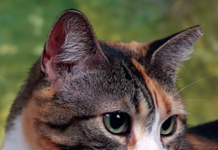Have you ever seen a cat with outrageously big feet? If you take a closer look, you may discover that the cat has a few more toes than the usual five in front and four in back. Polydactyl (literally, many fingers) is a genetic anomaly that is the result of a spontaneous mutation of a single gene. Most mutations are inherited as recessive alleles to the normal gene, explains Elizabeth Oltenacu, PhD, associate professor of animal science at Cornell University, who says that polydactylism results from the expression of a dominant gene that has variable expressivity.
Cats that have this gene dont always clearly show the effects of it, adds Oltenacu. Some cats are so mildly affected that abnormalities can be seen only on radiographs, while others may only have an enlarged thumb, or first digit. Certain cats may have as many as three or four extra toes on the front feet. Hind feet can be affected as well, but rarely are there extra toes on the hind feet unless there are extras up front. Genes switch on and off during fetal development, which is partly why this gene is variable in its expression, says Oltenacu. Tiny differences in when it is active will influence how much it can affect the development of the feet. These chance influences during fetal development account for the variability of expression of the polydactyl gene.
From hearty New England stock
The presence of these extra digits does not seem to inhibit the cat in any way. Folk tales often credit polydactylous cats with greater than average hunting success. They were considered to be superior mousers by some sailors and ship captains who may have deliberately selected these cats for their voyages. Their fabled hunting prowess may have brought the handy feline to the New World with the Puritans in 1630. While rare in most parts of the world, polydactylous cats are commonplace in parts of New England and maritime Canada. So familiar are they in eastern Massachusetts that they are frequently called the Boston cat. Population geneticists believe some of the first domestic cats to disembark in Boston were polydactyls.
These unique first-comers were able to influence the genetic make-up of subsequent generations, a phenomenon called the founder effect. If polydactyls made up the majority of the first cats to reach the young Massachusetts Bay colony, by the time the next arrivals appeared a larger population of extra-toed cats greeted them. Early Bostonians must have favored big-footed cats and actively selected for the trait. The dominant mutant allele (one of the alternative forms of a gene that may occur at a given position in a chromosome) for polydactylism was able to persist in the gene pool in the Boston area at a high percentage and persists today. The cat populations of Halifax and Yarmouth in Nova Scotia reflect the origins and movements of people and supplies. These towns were settled and supplied in the mid-eighteenth century by people from the Boston area, and not surprisingly, both cities have large populations of polydactylous cats.
The popular Maine Coon cat, a breed descended from generations of hearty New England stock, was frequently a polydactyl. Polydactyls comprised 40 percent of the original unregistered Maine Coon population. Breed associations, worried that the presence of the polydactyl gene might harm the soundness of the breed, historically have been reluctant to allow polydactyls to be shown in championship competition. The purebred Pixie Bob is also often a polydactyl. The International Cat Association has recently accepted Pixie Bob polydactyls for championship status. Except for the occasional ingrown nail, extra-toed cats are as healthy as other cats.



